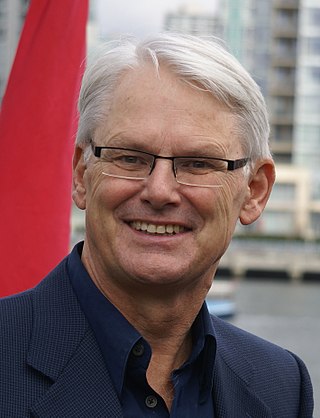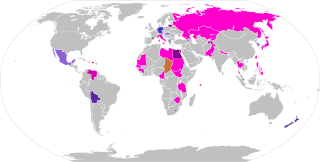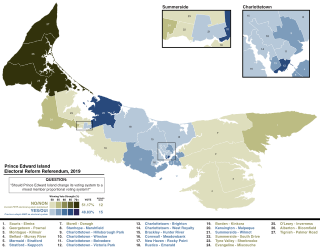Related Research Articles
Proportional representation (PR) refers to any type of electoral system under which subgroups of an electorate are reflected proportionately in the elected body. The concept applies mainly to political divisions among voters. The essence of such systems is that all votes cast – or almost all votes cast – contribute to the result and are effectively used to help elect someone. Under other election systems, a bare plurality or a scant majority are all that are used to elect candidates. Further, a PR system is one that produces mixed and balanced representation, reflecting how votes are cast.

Mixed-member proportional representation is a mixed electoral system which combines local majoritarian elections with a compensatory tier of party list votes, which are used to allocate additional members in a way that aims to produce proportional representation overall. In most MMP systems, voters get two votes: one to decide the representative for their single-seat constituency, and one for a political party. Some countries use single vote variants of MMP, although this article focuses primarily on dual vote versions of MMP.

Electoral reform in New Zealand has been a political issue in the past as major changes have been made to both parliamentary and local government electoral systems.
Canada holds elections for legislatures or governments in several jurisdictions: for the federal (national) government, provincial and territorial governments, and municipal governments. Elections are also held for self-governing First Nations and for many other public and private organizations including corporations and trade unions. Municipal elections can also be held for both upper-tier and lower-tier governments.

The 2005 British Columbia general election was held on May 17, 2005, to elect members of the Legislative Assembly (MLAs) of the Province of British Columbia (BC), Canada. The British Columbia Liberal Party formed the government of the province prior to this general election under the leadership of Premier Gordon Campbell. The main opposition was the British Columbia New Democratic Party, whose electoral representation was reduced to two MLAs in the previous provincial election in 2001.

A referendum was held in the Canadian province of British Columbia on May 17, 2005, to determine whether or not to adopt the recommendation of the Citizens' Assembly on Electoral Reform to replace the existing first-past-the-post electoral system (FPTP) with a single transferable vote system (BC-STV). It was held in conjunction with the BC Legislative Assembly election of 2005. Voters were given two ballots at that time: a ballot to vote for a Member of the Legislative Assembly of British Columbia (MLA) in their constituency and a referendum ballot. The referendum received considerable support from the electorate but failed in meeting the 60-percent threshold that had been set. A second referendum was held in 2009.
The Citizens' Assembly on Electoral Reform was established by the government of the province of Ontario, Canada, in March 2006. Modelled on the British Columbia equivalent, it reviewed the first past the post electoral system currently in use to elect members of the Ontario Legislature, with the authority to recommend an alternative. In May 2007, the assembly recommended, in a decision of 94 to 8, that Ontario adopt a form of mixed member proportional representation (MMP).

A referendum was held on October 10, 2007, on the question of whether to establish a mixed member proportional representation (MMP) system for elections to the Legislative Assembly of Ontario. The vote was strongly in favour of the existing plurality voting or first-past-the-post (FPTP) system.
BC-STV is the proposed voting system recommended by the Citizens' Assembly on Electoral Reform in October 2004 for use in British Columbia, and belongs to the single transferable vote family of voting systems. BC-STV was supported by a majority of the voters in a referendum held in 2005 but the government had legislated that it would not be bound by any vote lower than 60 percent in favour. Because of the strong majority support for BC-STV, the government elected to stage a second referendum in 2009, but with increased public funding for information campaigns to better inform the electorate about the differences between the existing and proposed systems. The leadership of both the "yes" side and the "no" side were assigned by the government. The proposal was rejected with 60.9 percent voting against, vs. 39.1 percent in favour, in the 2009 vote.
Historically, the single transferable vote (STV) electoral system has seen a series of relatively modest periods of usage and disusage throughout the world; however, today it is seeing increasing popularity and proposed implementation as a method of proportional representation and a goal of electoral reform. STV has been used in many different local, regional and national electoral systems, as well as in various other types of bodies, around the world.
The Politics of British Columbia involve not only the governance of British Columbia, Canada, and the various political factions that have held or vied for legislative power, but also a number of experiments or attempts at political and electoral reform.

Following the 2005 electoral reform referendum, British Columbia held a second referendum on electoral reform in conjunction with the provincial election on May 12, 2009. As in 2005, voters in 2009 were asked were asked which electoral system should be used to elect legislators: the existing first-past-the-post electoral system or the BC single transferable vote electoral system (BC-STV) proposed by the British Columbia Citizen's Assembly on Electoral Reform to ensure more proportional representation in the provincial Legislative Assembly.
A referendum was held in the Canadian province of Prince Edward Island on November 28, 2005, to determine whether to adopt the Mixed Member Proportional (MMP) system as recommended by the Prince Edward Island Electoral Reform Commission in 2003.
Electoral reform is a change in electoral systems which alters how public desires are expressed in election results.
Dual-member proportional representation (DMP), also known as dual-member mixed proportional, is an electoral system designed to produce proportional election results across a region by electing two representatives in each of the region’s districts. The first seat in every district is awarded to the candidate who receives the most votes, similar to first-past-the-post voting (FPTP). The second seat is awarded to one of the remaining district candidates so that proportionality is achieved across the region, using a calculation that aims to award parties their seats in the districts where they had their strongest performances.

A mixed electoral system or mixed-member electoral system combines methods of majoritarian and proportional representation (PR). The majoritarian component is usually first-past-the-post voting (FPTP/SMP), whereas the proportional component is most often based on party-list PR. The results of the combination may be mixed-member proportional (MMP), where the overall results of the elections are proportional, or mixed-member majoritarian, in which case the overall results are semi-proportional, retaining disproportionalities from the majoritarian component.

A referendum on electoral reform took place by mail-in ballot between October 22 and December 7, 2018, in the Canadian province of British Columbia. 61.3 percent of voters supported maintaining the first-past-the-post voting system rather than switching to a proportional representation voting system, which was supported by 38.7 percent of voters. This was British Columbia's third referendum on electoral reform, following ones in 2005 and 2009.

Rural–urban proportional representation (RUP), also called flexible district PR, is a mixed electoral system which combines the use of single- and multi-member constituencies in a lower tier and top-up seats in an upper tier to meet the different needs of both rural and urban areas, while protecting the objective of proportionality. The term was coined by Fair Vote Canada, which devised a rural–urban system with the intention of meeting the special challenges of Canada's geography, which includes wide-flung, sparsely populated areas.

A referendum on electoral reform was held on April 23, 2019, in the Canadian province of Prince Edward Island – simultaneously with the 2019 provincial election – to determine if the province should adopt a mixed-member proportional representation voting system (MMP). A narrow majority voted to keep the existing first-past-the-post system. However, the referendum was not binding, as neither the yes or no side received majority support in 60% or more of the province's 27 electoral districts.
Mixed-member majoritarian representation (MMM) is type of a mixed electoral system combining winner-take-all and proportional methods, where the disproportional results of the winner-take-all part are dominant over the proportional component. Mixed member majoritarian systems are therefore categorized under semi-proportional representation, and are usually contrasted with mixed-member proportional representation (MMP) which aims to provide proportional representation compensation ("top-up") seats.
References
- 1 2 Electoral History of British Columbia, Supplement 2002—2013 (PDF). Victoria, British Columbia: Elections BC and the Legislative Library of British Columbia. 2014. pp. 129–130. Retrieved February 28, 2023.
- ↑ "STV referendum part of election". Archived from the original on July 5, 2009. Retrieved April 23, 2009.
- 1 2 "Episode 8: MASS LBP's approach with Peter MacLeod". Facilitating Public Deliberations (Podcast). newDemocracy Foundation. February 26, 2020. 2:57–6:42. Retrieved June 27, 2023.
- ↑ Elections BC (May 17, 2005). Report of the Chief Election Officer: 38th Provincial Election/2005 Referendum on Electoral Reform (PDF). p. 34.
- 1 2 3 Citizen's Assembly on Electoral Reform of British Columbia, Final Report (December 2004). Making Every Vote Count: The Case for Electoral Reform in British Columbia (PDF). p. 10-13. Archived from the original (PDF) on November 15, 2017.
- ↑ LeDuc, Lawrence; Heather Bastedo; Catherine Baquero (June 4–6, 2008). "The Quiet Referendum: Why Electoral Reform Failed in Ontario" (PDF). Presented at the Annual Meeting of the Canadian Political Science Association: 10–11. Archived from the original (PDF) on November 11, 2014.
- ↑ "Special Committee on the Citizens' Assembly on Electoral Reform" (PDF). Legislative Assembly of British Columbia. February 2005. Retrieved February 28, 2023.
- ↑ Elections BC (May 12, 2009). Statement of Votes – Referendum on Electoral Reform (PDF). p. 20.
- 1 2 Pal, Michael (2012). "The Promise and Limits of Citizens' Assemblies: Deliberation, Institutions and the Law of Democracy" (PDF). Queen's University at Kingston. 38: 259–294. Archived from the original (PDF) on November 2, 2017. Retrieved March 26, 2019.
- ↑ Fishkin, James (December 20, 2018). "Response to Critics: Toward the Reform of Actually Existing Democracies". The Good Society. 27 (1–2): 207. doi:10.5325/goodsociety.27.1-2.0190. ISSN 1089-0017.
- ↑ Webb, P. (2013) 'Patrick Fournier, Henk van der Kolk, R. Kenneth Carty, Andre Blais and Jonathan Rose, When citizens decide: Lessons from citizen assemblies on electoral reform, reviewed by Paul Webb', Party Politics, 19(5), pp. 845–847. doi:10.1177/1354068813494000.
- ↑ Blais, André & Carty, Kenneth & Fournier, Patrick. (2005). Citizens' Choice of an Electoral System: The Decision of the Bc Citizens' Assembly. Page 11.
- ↑ Lang, Amy (March 1, 2007). "But Is It for Real? The British Columbia Citizens' Assembly as a Model of State-Sponsored Citizen Empowerment". Politics & Society. 35: 35–70. doi:10.1177/0032329206297147. S2CID 1852236.